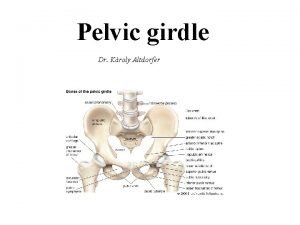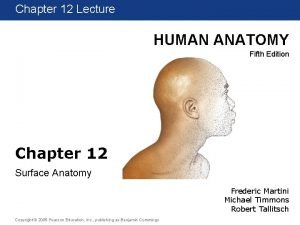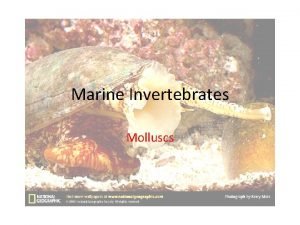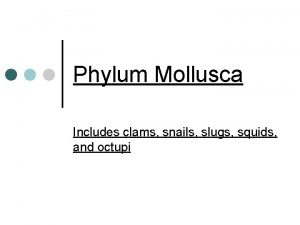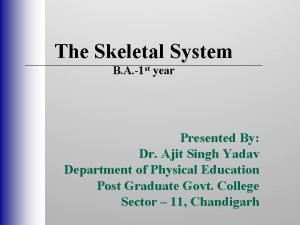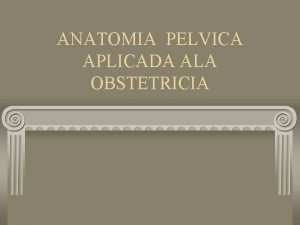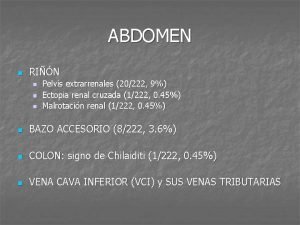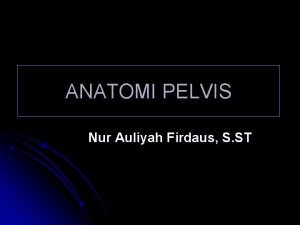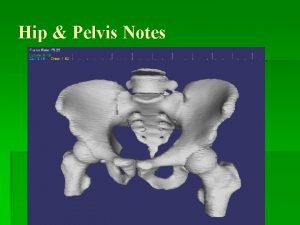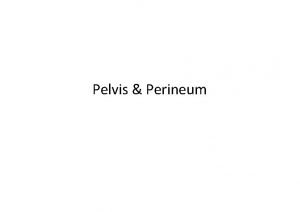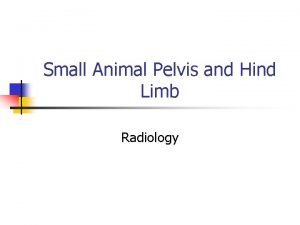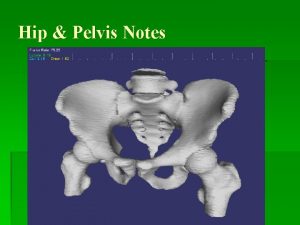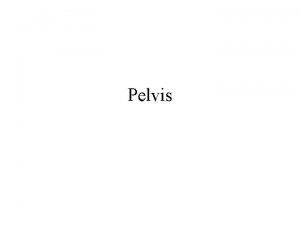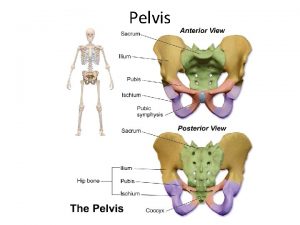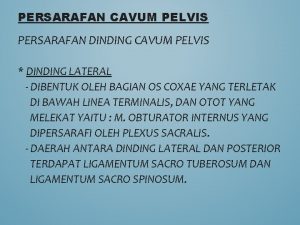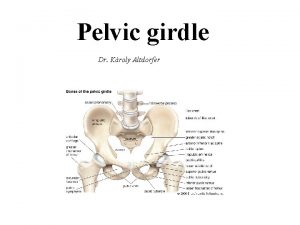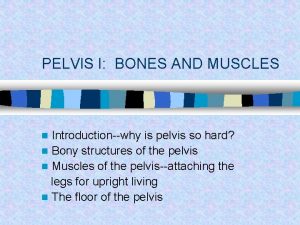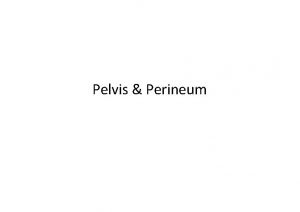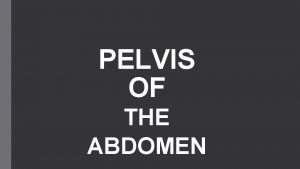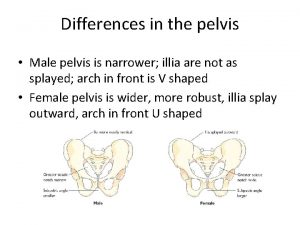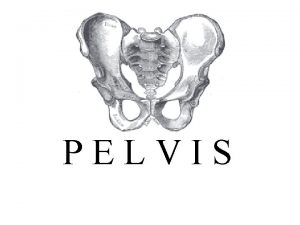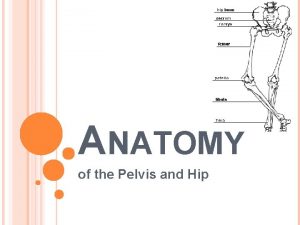Ultrasonographic anatomy of the pelvis including its 3








































































- Slides: 72


Ultrasonographic anatomy of the pelvis including its 3 D aspects Frédéric Chantraine, ULg

Introduction • Anatomy of the pelvis • Ultrasound techniques • Female organs in the pelvis • Uterus • Ovaries • Fallopian Tubes

The female pelvis


And in ultrasound? • Different approaches: – Transvaginal • Bladder is empty – Transabdominal • Bladder is filled – Transrectal – Transperineal

And in ultrasound? • Different techniques – Classic “ 2 D” – Colour and Pulsed Doppler – Volumetric “ 3 D”

Uterus

Uterus • Organ of reference in the pelvis • Different orientation – Ante-, retroflexion – Ante-, retroversion • Three main parts – Corpus – Isthmus – Cervix

Uterus • Classic plans Longitudinal Transversal

Uterus – Coronal plan by 3 D

Uterus – Coronal plan by 3 D

Uterus – Completed by transabdominal scan

Transabdominal scan – Check if possible the kidneys • Dilation by ureter-compression (Myomas, …) • In combination with congenital uterine malformations

Uterus • Volume depends – Patient age – Number of gestations – Endocrinal level

Uterus

Main uterine diameters during different stages of life LONG. DIAMETER ANT-POST DIAMETER TRANS. DIAMETER VOLUME PREPUBERTAL 1 -3 cm 0, 5 -1 cm 10 -20 ml MULTIPAROUS 8 cm 4 cm 5 cm 60 -80 ml NULLIPAROUS 6 cm 3 -4 cm 30 -40 ml POSTMENOPA USAL 4 -6 cm 2 -3 cm 14 -17 ml Platt, 1990. Modified

Normal dimensions of the uterus before puberty Uterine diameter (cm) Uterine volume (cm 3) Age N°. Pts. DL DAP cervix 2 7 33. 1 4. 4 7. 0 3. 4 8. 3 2. 0 1. 98 1. 58 3 8 32. 4 4. 3 6. 4 1. 3 7. 6 2. 2 1. 63 0. 81 4 15 32. 9 3. 3 7. 6 1. 8 8. 6 1. 8 2. 10 0. 57 5 7 33. 1 5. 5 8. 0 2. 8 8. 4 1. 8 2. 36 1. 39 6 9 33. 2 4. 1 6. 7 2. 9 7. 5 1. 80 1. 57 7 9 32. 3 3. 9 8. 0 2. 2 7. 7 2. 5 2. 32 1. 07 8 11 35. 8 7. 3 9. 0 2. 8 8. 4 1. 7 3. 12 1. 52 9 11 37. 1 4. 4 9. 7 3. 0 8. 8 2. 0 3. 70 1. 62 10 13 40. 3 6. 4 12. 8 5. 3 10. 7 2. 6 6. 54 3. 78 11 13 42. 2 5. 1 12. 8 3. 1 10. 7 2. 6 6. 66 2. 87 12 6 54. 3 8. 4 17. 3 5. 3 14. 3 5. 2 16. 18 9. 15 13 5 53. 8 11. 4 15. 8 4. 5 15. 0 2. 4 13. 18 5. 64 Orsini, 1984, Modified

Uterus – Myometrium • Three different layers

Uterus – Myometrium • Three different layers

Uterus – Myometrium • Contractile • bjl

Uterus – Vascularisation • Uterine artery • Arcuate artery • Radial artery • Spiral artery


Uterus – Doppler of the uterine artery • Systole: high velocity peak • Diastole: lower flow • Telesystolic Notch • Changes during menstrual cycle



Uterus – Endometrium 1. Thickness: technique of measurement

Uterus

Uterus

Uterus – Endometrium 2. Echostructure – Patients age – Moment of the spontaneous cycle – Eventual hormonal treatment

Uterus –Endometrium • Prepubertal age – Newborn: thickened and hyperechogenic – Up to menarch: thin, <1 mm – Useful in diagnosis of early or delayed puberty • Reproductive age

Uterus – Endometrium • Range of normal endometrial thicknesses THICKNESS (mm) PROLIFERATIVE PHASE 4 -8 PERIOVULATORY PHASE 6 -10 SECRETIVE PHASE 7 -14 POSTMENOPAUSAL PHASE <6

Appearance of the endometrial mucosa during the course of a physiological cycle Early proliferative phase Late proliferative phase Early luteal phase Late luteal phase L. Savelli, ISUOG

Early proliferative phase

Late proliferative phase

Early luteal phase

Late luteal phase

And the next step?

Postmenopausal

To complete the uterus examination Check the cervix • Polyps • Myomas • Pregnancy location

IUD-Fibre Nabothian cyst

Cervical pregnancy


Ovary

Ovary • Location – Between uterus and pelvic wall – Behind uterus, Douglas pouch

Ovary • Dimension – Pré-ménopause: 3, 5 x 2 x 1, 5 cm – Post-ménopause: 1, 5 x 0, 7 cm • Morphology – Patient age – Moment of the menstrual cycle

Ovary • Prepubertal – Small hypoechogenic masse – Years before puberty: • Increase in volume • Follicles development

Ovary • Reproductive age – Classic multifollicular form

Ovary • Reproductive age – Mid-cycle: dominant follicle (10 to 20 -25 mm)

Ovary • Reproductive age – After ovulation: corpus luteum

Ovary • Reproductive age – After ovulation: free fluid in the Douglas

Ovary • Reproductive age – Functional cysts

Ovary • Reproductive age – Functional cysts with Mirena® IUD

Ovary • Reproductive age – Polycystic ovary

Ovary and 3 D

Ovary and 3 D

Ovary and 3 D

Ovary and 3 D

Ovary and 3 D

Ovary • Postmenopausal – Small masses, difficult to visualize

Ovary • Post-menopausal – Unilocular cysts “Small (< or = 50 mm) benign adnexal cysts and small benign solid tumors are so common in postmenopausal women that their presence may be regarded as normal” L. Valentin UOG 2003

Fallopian Tubes

Fallopian Tubes • Anatomy – Interstitielle – Isthmus – Ampulla • Difficult to visualize – Fluid around – Hydrosalpinx

Fallopian Tubes © Luca Savelli

And what else?


Cervix after subtotal hysterectomy

Pelvic kidney

Bladder filling

Heterotopic pregnancy

Dank uw ! Questions?

Don’t worry, they normally look like little humans during the early scans
 Minor pelvis
Minor pelvis Anatomy region
Anatomy region Hip retroversion vs anteversion
Hip retroversion vs anteversion Nelaton's line test
Nelaton's line test Pelvis surface anatomy
Pelvis surface anatomy When a train increases its velocity, its momentum
When a train increases its velocity, its momentum Its not easy but its worth it
Its not easy but its worth it Windy snowy rainy sunny
Windy snowy rainy sunny If its square its a sonnet summary
If its square its a sonnet summary The emigree and london comparison
The emigree and london comparison Its halloween its halloween the moon is full and bright
Its halloween its halloween the moon is full and bright độ dài liên kết
độ dài liên kết Kể tên các môn thể thao
Kể tên các môn thể thao Khi nào hổ mẹ dạy hổ con săn mồi
Khi nào hổ mẹ dạy hổ con săn mồi điện thế nghỉ
điện thế nghỉ Một số thể thơ truyền thống
Một số thể thơ truyền thống Biện pháp chống mỏi cơ
Biện pháp chống mỏi cơ Trời xanh đây là của chúng ta thể thơ
Trời xanh đây là của chúng ta thể thơ Voi kéo gỗ như thế nào
Voi kéo gỗ như thế nào Bảng số nguyên tố
Bảng số nguyên tố Thiếu nhi thế giới liên hoan
Thiếu nhi thế giới liên hoan Tỉ lệ cơ thể trẻ em
Tỉ lệ cơ thể trẻ em Fecboak
Fecboak Các châu lục và đại dương trên thế giới
Các châu lục và đại dương trên thế giới Thế nào là hệ số cao nhất
Thế nào là hệ số cao nhất Hệ hô hấp
Hệ hô hấp Tư thế ngồi viết
Tư thế ngồi viết Hình ảnh bộ gõ cơ thể búng tay
Hình ảnh bộ gõ cơ thể búng tay đặc điểm cơ thể của người tối cổ
đặc điểm cơ thể của người tối cổ Mật thư tọa độ 5x5
Mật thư tọa độ 5x5 Chụp tư thế worms-breton
Chụp tư thế worms-breton Tư thế ngồi viết
Tư thế ngồi viết ưu thế lai là gì
ưu thế lai là gì Thẻ vin
Thẻ vin Bàn tay mà dây bẩn
Bàn tay mà dây bẩn Thể thơ truyền thống
Thể thơ truyền thống Các châu lục và đại dương trên thế giới
Các châu lục và đại dương trên thế giới Từ ngữ thể hiện lòng nhân hậu
Từ ngữ thể hiện lòng nhân hậu Diễn thế sinh thái là
Diễn thế sinh thái là Thế nào là giọng cùng tên
Thế nào là giọng cùng tên 101012 bằng
101012 bằng Alleluia hat len nguoi oi
Alleluia hat len nguoi oi Hổ đẻ mỗi lứa mấy con
Hổ đẻ mỗi lứa mấy con đại từ thay thế
đại từ thay thế Quá trình desamine hóa có thể tạo ra
Quá trình desamine hóa có thể tạo ra Vẽ hình chiếu vuông góc của vật thể sau
Vẽ hình chiếu vuông góc của vật thể sau Công thức tính thế năng
Công thức tính thế năng Thế nào là mạng điện lắp đặt kiểu nổi
Thế nào là mạng điện lắp đặt kiểu nổi Các loại đột biến cấu trúc nhiễm sắc thể
Các loại đột biến cấu trúc nhiễm sắc thể Lời thề hippocrates
Lời thề hippocrates Vẽ hình chiếu đứng bằng cạnh của vật thể
Vẽ hình chiếu đứng bằng cạnh của vật thể Bổ thể
Bổ thể The mutcd recommends the use of emergency vehicles
The mutcd recommends the use of emergency vehicles Square pyramid faces edges vertices
Square pyramid faces edges vertices Printed words including dialogue
Printed words including dialogue Animals including humans year 6
Animals including humans year 6 Animals including humans year 4
Animals including humans year 4 Including samuel discussion questions
Including samuel discussion questions It encompasses several different aspects, including
It encompasses several different aspects, including Animals including humans
Animals including humans George and tamara doesn't want to see that movie
George and tamara doesn't want to see that movie Invertebrates including snails slugs and mussels
Invertebrates including snails slugs and mussels How to ice a quote
How to ice a quote Invertebrates including snails slugs and mussels
Invertebrates including snails slugs and mussels Billy wigglestick
Billy wigglestick Presentatio pelvina
Presentatio pelvina Figure 5-11 is a diagram of the articulated pelvis
Figure 5-11 is a diagram of the articulated pelvis Shy lovers try positions they can't handle
Shy lovers try positions they can't handle Osteotomia de pelvis
Osteotomia de pelvis Fetal başın kardinal hareketleri
Fetal başın kardinal hareketleri Estrecho inferior de la pelvis
Estrecho inferior de la pelvis Pelvis extrarrenales bilaterales
Pelvis extrarrenales bilaterales
